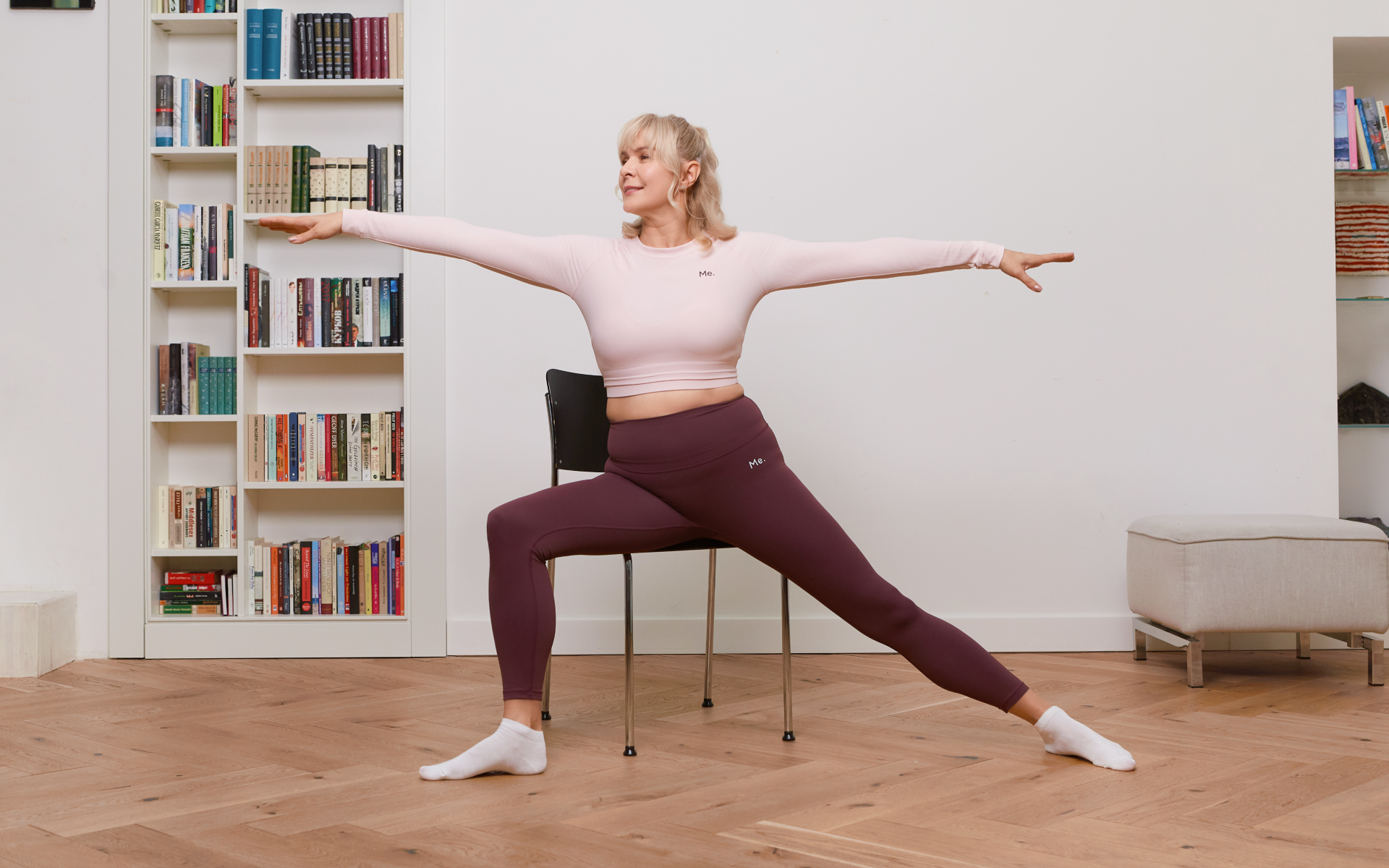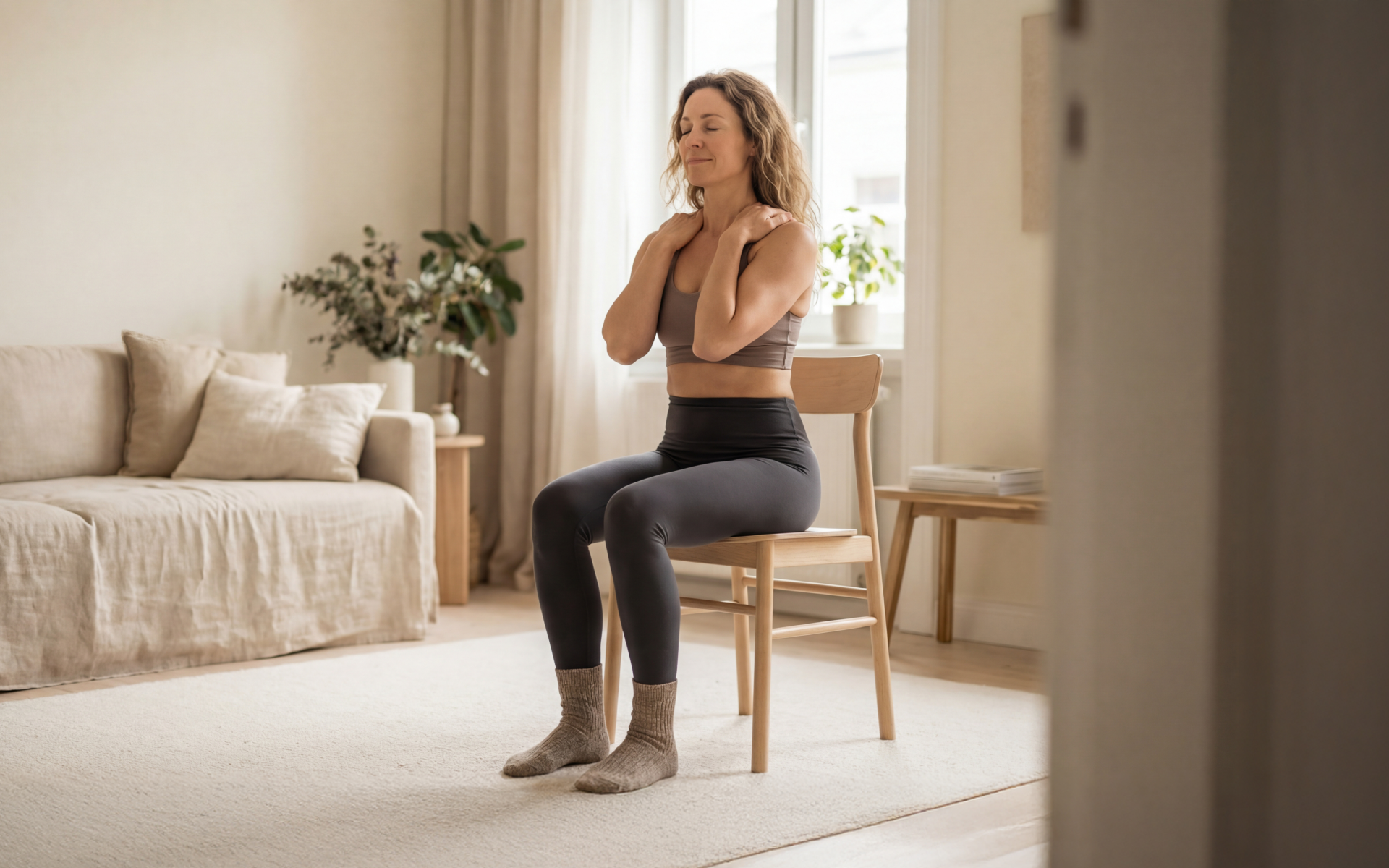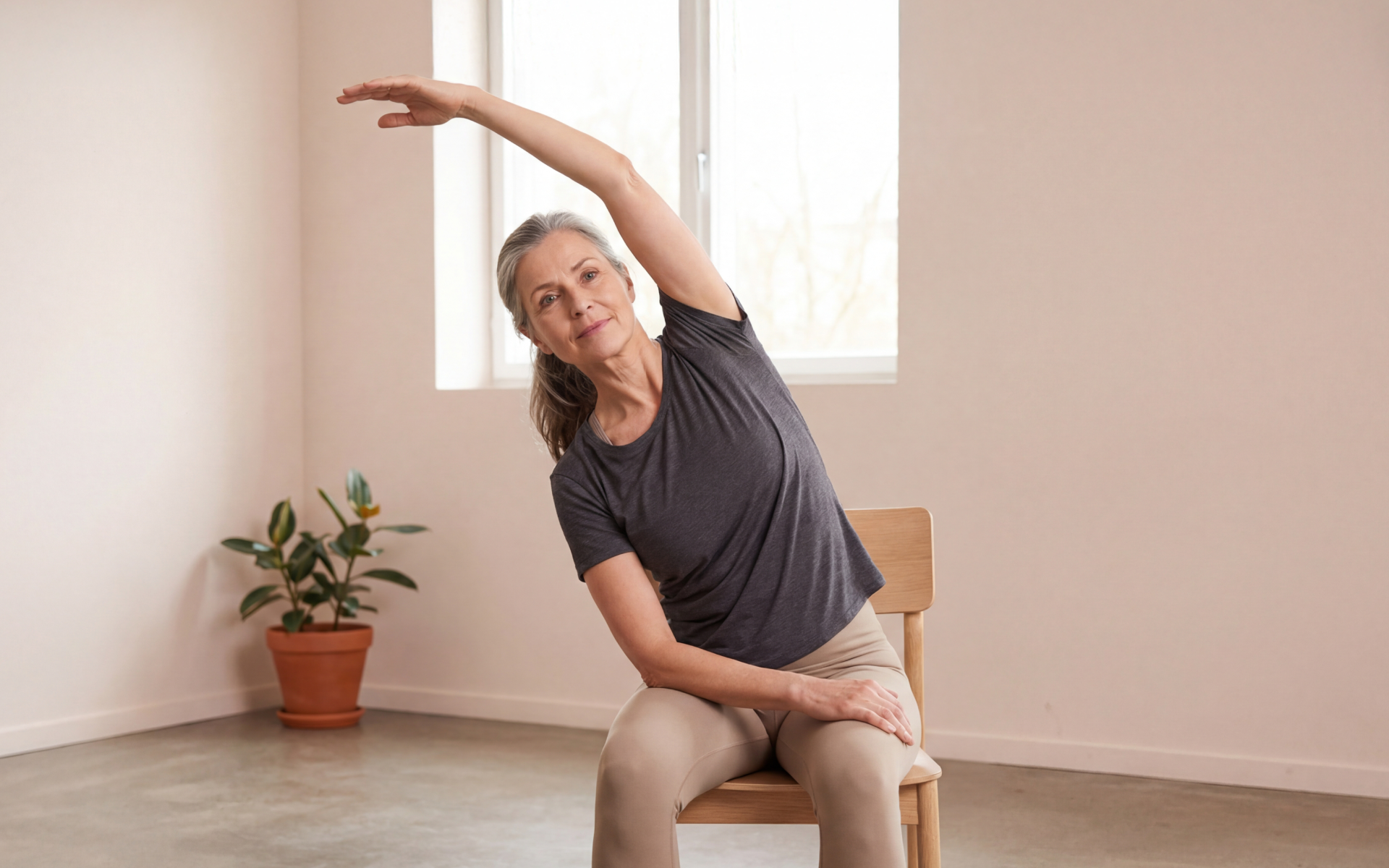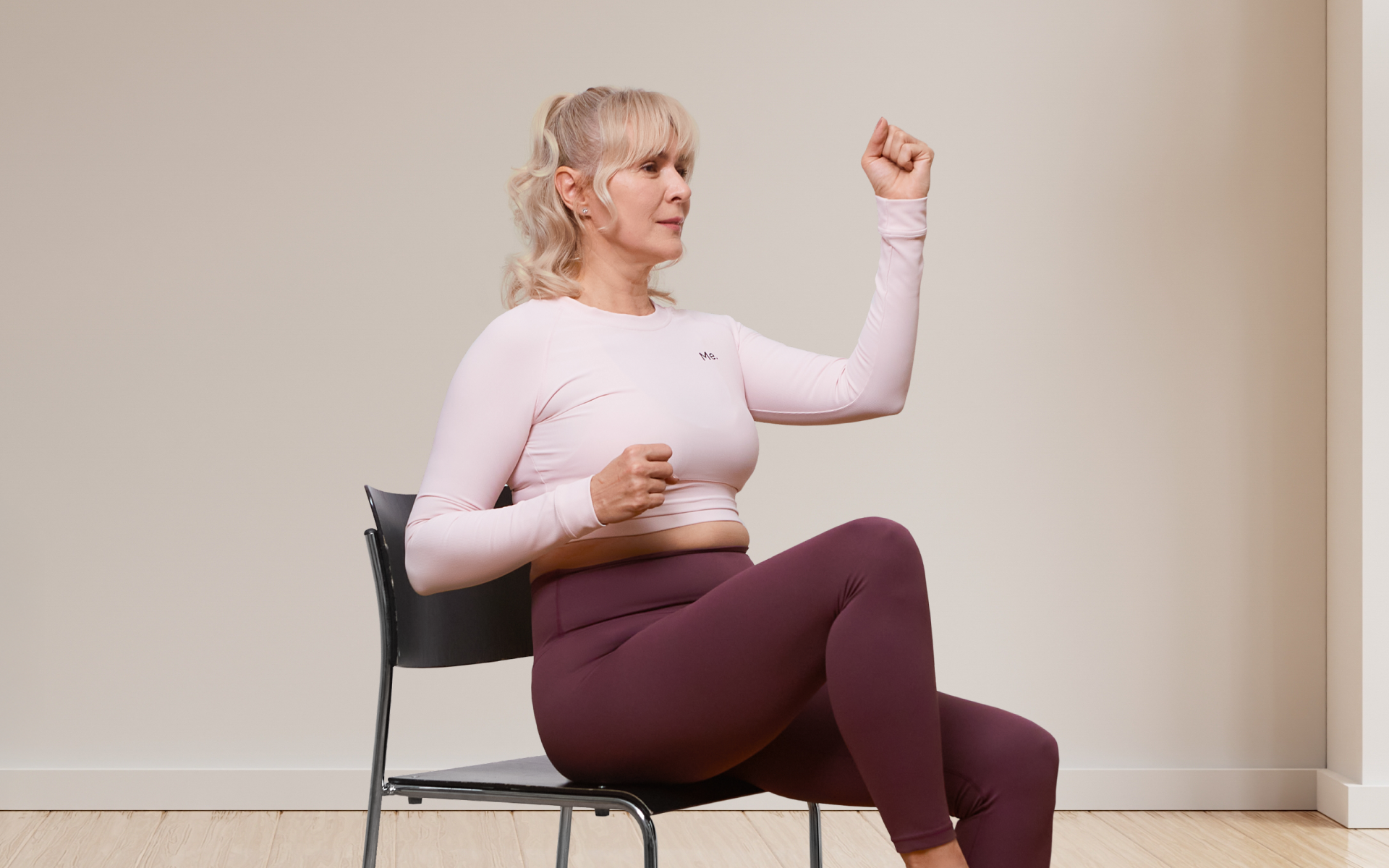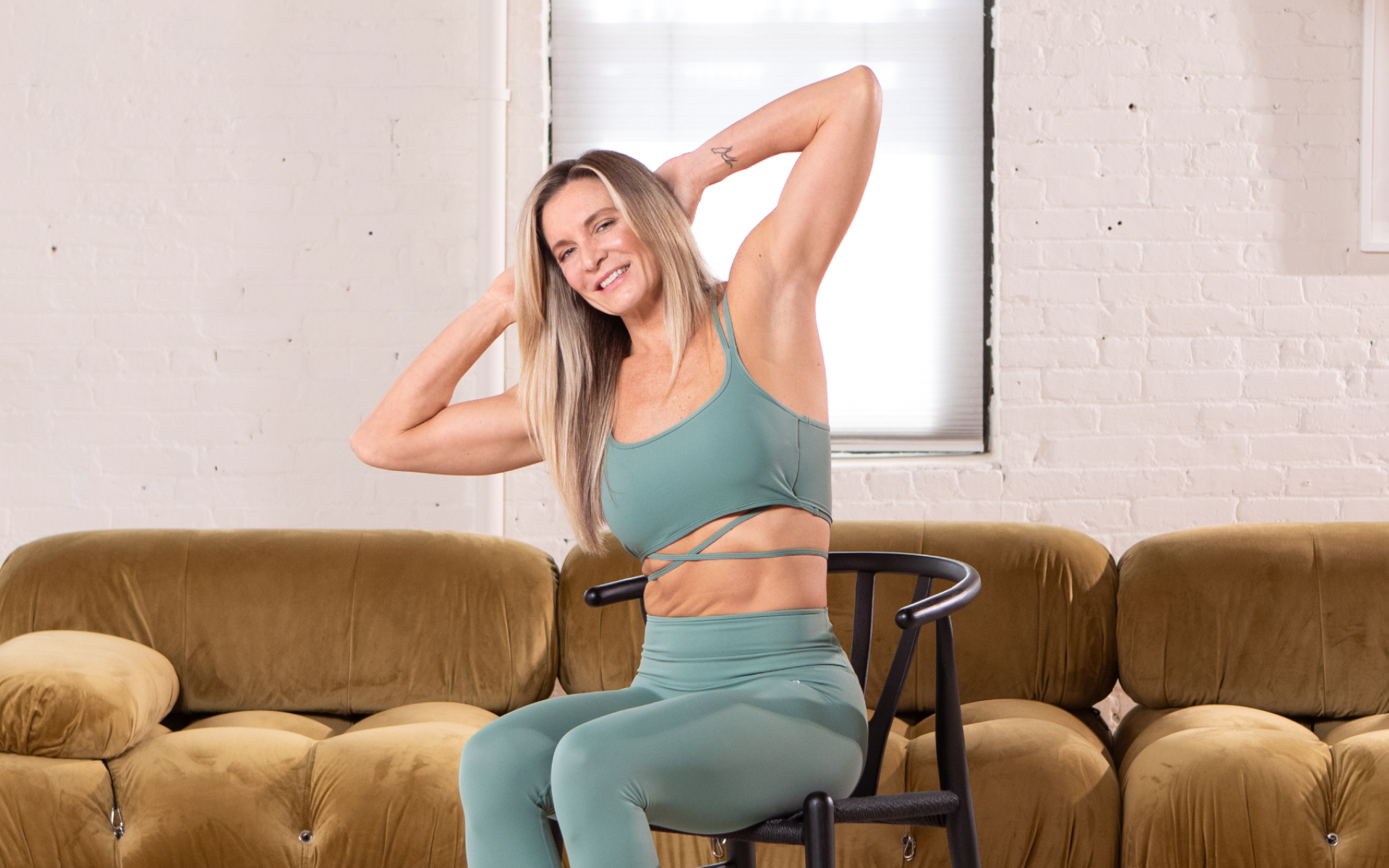Imagine being able to walk, run or climb stairs without worrying that your knees might give out. Or how about being pain-free while sitting cross-legged on the floor for a period of time.
You can achieve this through regular exercise, and one great form of exercise for your knees is chair yoga.
Chair yoga is exactly what it sounds like – yoga exercises done while sitting on a chair. It’s low impact, meaning it’s gentle on your joints and perfect for those with limited mobility. Even if you don’t have knee issues, chair yoga can help strengthen your knees and prevent future problems.
Here are 8 chair yoga moves that specifically target the muscles and ligaments around your knees:
What Is Chair Yoga for Knees?
Chair yoga for knees involves performing poses and movements while seated on a chair or using it for support. It’s a great way to enhance knee strength, flexibility, and range of motion while minimizing stress on the joints (1).
This practice promotes joint health and stability, making it beneficial for anyone looking to strengthen their knees and improve mobility. However, it’s essential to consult a doctor before starting any exercise routine to ensure it’s appropriate for your individual needs.
Adding chair yoga to your routine can support long-term knee health and enhance physical performance.
Can People with Bad Knees Do Yoga?
To enhance knee strength and support overall mobility, individuals should consult their doctor or physical therapist before starting any new exercise routine, including chair yoga. This is especially important if you have existing knee issues or are prone to injuries.
Generally speaking, chair yoga can be modified and tailored to fit the needs and limitations of those with knee problems. The beauty of chair yoga is that it allows individuals to safely perform exercises without putting too much pressure on the knees. By using a chair as support, individuals can reduce strain on their joints while still getting a great workout.
In our blog, How To Exercise With Bad Knees To Lose Weight we discuss safe ways to exercise.
What Are the 5 Benefits of Chair Yoga for Knees?
Chair yoga for knees offers numerous benefits for those looking to prevent knee issues, providing a gentle and accessible way to enhance flexibility, strength, and balance. Let’s explore these benefits in detail:
1. Improved Knee Strength
Incorporating chair yoga moves that focus on the knees can enhance the muscles surrounding the knee joint, providing better support and stability to prevent issues down the line (2).
2. Increased Flexibility
Gentle stretching movements in chair yoga can boost flexibility in the knees, enhancing your range of motion and making daily activities easier and more enjoyable (1).
Lean and toned up body isn’t just a far-fetched fantasy. Check out the BetterMe: Health Coaching app and watch it propel your weight loss journey into high gear!
3. Reduced Inflammation
Chair yoga can help mitigate chronic inflammation, promoting overall joint health and reducing the risk of developing knee-related issues over time (3).
4. Better Posture and Balance
Regular practice of chair yoga can support postural control and balance, lowering the risk of falls and injuries, which is especially helpful for maintaining healthy knees (1).
5. Stress Relief and Relaxation
With its focus on breathing techniques and mindfulness, chair yoga encourages relaxation and stress reduction, contributing to overall well-being and a proactive approach to knee health (4).
Find more information on safe exercises for bad knees in our, Knee Therapeutic Exercises article.
8 Chair Yoga Poses for Knees
Chair yoga for knees includes gentle movements that focus on improving flexibility and strength, without putting excessive stress on the joints. These exercises typically involve slow, controlled motions that promote circulation and enhance range of motion.
The routines encourage mindful breathing and relaxation, making them accessible for everyone, regardless of age or fitness level. Participants can easily adapt these movements to their comfort level, ensuring a safe and effective practice that supports knee health. Here are some of the them:
1. Seated Knee Extension
Seated Knee Extension is an effective exercise designed to strengthen the muscles around the knee joint, particularly the quadriceps. By focusing on extending the knee while seated, this movement helps to build endurance and stability in the knee, promoting overall joint health and preventing potential issues.
Steps
- Sit comfortably in a chair with your feet flat on the ground, hip-width apart.
- Slowly lift one foot off the ground, extending your leg straight.
- Hold the extended position for a few seconds, feeling the stretch in the quadriceps.
- Lower your foot back down to starting position.
- Repeat the extension for 10-15 repetitions before switching to the other leg.
- Focus on controlled movements and alignment to avoid any strain.
2. Chair Pigeon Pose
Chair Pigeon Pose offers a gentle stretch for the hips and knees, targeting the surrounding muscles to promote flexibility and relieve tension. This pose aids in improving blood circulation around the knee joint, enhancing mobility and supporting the prevention of knee injuries.
Steps
- Sit on the edge of your chair with your feet flat on the floor.
- Lift your right ankle and place it on your left knee, creating a figure-four position.
- Keep your back straight and gently lean forward, feeling a stretch in your right hip and knee.
- Hold the position for 15-30 seconds, ensuring you breathe deeply.
- Return to the starting position and switch sides.
- Repeat this move 2-3 times on each leg to promote flexibility.
Read more: 21 Day Chair Yoga: Reasons To Add This Challenge To Your Routine
3. Seated Knee Circles
Seated Knee Circles involve gently rotating the knee joint to enhance mobility and warm up the surrounding muscles. This exercise helps in maintaining joint health and preventing stiffness, promoting overall knee health.
Steps
- Sit tall in your chair with knees together and feet flat on the floor.
- Lift one foot slightly off the ground.
- Begin making small circles with your knee, moving clockwise for 10-15 repetitions.
- Reverse the direction and circle counterclockwise for another 10-15 repetitions.
- Keep your upper body still and focus on the movement in your knee.
- Switch to the other leg and repeat the circles.
4. Chair Calf Raises
Chair Calf Raises are gentle on the knees while targeting the calves, helping to build strength in the muscles that support the ankles.
Steps
- Sit comfortably in your chair with your back straight and feet flat on the floor.
- Slowly raise your heels off the ground, keeping your toes on the floor.
- Hold for 5 seconds, engaging your calf muscles without straining your knees.
- Gradually lower your heels back to the ground.
- Repeat for 10-15 repetitions, focusing on smooth, controlled movements.
- Ensure your movements are gentle to avoid any discomfort in your knees.
5. Seated Tree Pose
Seated Tree Pose enhances sitting balance and strengthens the knees by requiring stability in the lower body while seated.
Steps
- Sit upright in your chair with your feet flat on the ground.
- Lift your right foot off the floor and place the sole of your foot against the inner thigh of your left leg.
- Keep your back straight and your hands resting on your knees or clasped in front of your chest.
- Hold this position for 10-15 seconds, breathing deeply to maintain focus.
- Lower your foot back down and switch to the other leg.
- Repeat this pose 2-3 times on each leg to enhance balance and strength.
6. Chair Goddess Pose
Chair Goddess Pose encourages good alignment and stability, both of which are essential for maintaining knee health and preventing injuries.
Steps
- Sit with your feet wide apart, toes pointed slightly outward while resting on the edge of your chair.
- Press your knees gently outward as you engage your inner thigh muscles.
- Place your hands on your hips or rest them on your thighs for support.
- Hold the pose for 15-30 seconds, focusing on your breath and the sensations in your knees.
- Release the position and return to a neutral seated posture.
- Repeat the pose 2-3 times to build strength and flexibility.
7. Chair Crescent Lunge
The Chair Crescent Lunge is an excellent pose for opening the hips and stretching the muscles surrounding the knee joint. This exercise not only promotes flexibility but also improves stability by engaging the core and lower body. It’s particularly beneficial for enhancing the range of motion in the knees while promoting a sense of grounding and balance.
Steps
- Sit towards the edge of your chair with your feet flat on the floor, hip-width apart.
- Shift your weight to your right side and extend your left leg back, keeping it straight and in line with your hip.
- Make sure your right knee is aligned over your right ankle, creating a 90-degree angle.
- Raise your arms overhead, reaching towards the ceiling while keeping your shoulders relaxed.
- Hold this position for 15-30 seconds, breathing deeply to feel the stretch in your hips and thighs.
- Return to the starting position and repeat on the other side.
- Perform this pose 2-3 times on each leg to promote overall flexibility and mobility.
8. Seated Knee Hug
The Seated Knee Hug is a gentle exercise that focuses on stretching the lower back and hips, and knees. This movement enhances circulation around the knee joint and promotes relaxation, making it a great addition to any chair yoga routine.
Steps
- Sit comfortably in your chair with your back straight and feet flat on the ground.
- Lift your right knee towards your chest, using your hands to gently pull your leg in closer.
- Hold your knee with both hands, making sure you keep your back straight and engage your core.
- Breathe deeply and hold the position for 15-30 seconds, noticing the stretch in your lower back and the release in your knee.
- Lower your right leg back to the starting position and repeat with the left leg.
- Aim to perform this stretch 2-3 times on each side, enhancing flexibility and promoting relaxation throughout your lower body.
Looking for a way to break the vicious cycle of weight loss and tone up all the jiggly parts? Watch the extra pounds fly off and your muscles firm up with the BetterMe: Health Coaching app!
Is Yoga or Pilates Better for Knee Pain?
The best exercises for knee pain are those which your physiotherapist or doctor recommends for you. While both yoga and Pilates can be beneficial in easing knee pain, it’s essential to consult a professional before starting any new form of exercise. They will consider your individual health needs and provide personalized recommendations based on your condition.
That said, both yoga and Pilates have similarities when it comes to targeting knee pain. Both forms of exercise focus on strengthening the surrounding muscles, improving flexibility and mobility, and promoting relaxation. However, there are some differences that may make one more suitable than the other for an individual’s specific needs.
Yoga is a holistic practice that incorporates physical poses (asanas), breathing techniques (pranayama) and meditation to promote overall well-being. It can be beneficial for those with knee pain as it emphasizes slow and controlled movements, making it low impact and less likely to cause strain or injury (2).
Additionally, some yoga poses specifically target the knee joint, promoting stability, flexibility, and improved circulation.
On the other hand, Pilates is a form of exercise that focuses on core strength, alignment, and balance. While it also promotes full-body awareness and mind-body connection like yoga does, its main emphasis is on building strength and stability through controlled movements.
This can be particularly beneficial for individuals with knee pain who may need to strengthen their muscles for better support of the joints (5).
In the end, both chair yoga and Pilates can effectively help one manage knee pain, but the best choice may depend on individual preferences and needs. Chair yoga offers gentle movements that can enhance flexibility and strength, making it a great option for many.
We’ve discussed more knee strengthening moves in our, exercises to strengthen knees article.
FAQs
Is Tree Pose Bad for the Knees?
Tree Pose can be safe for the knees if performed correctly and with proper alignment. This pose requires you to balance on one leg while placing the opposite foot against your inner thigh or calf, which helps improve stability and strength.
Focus on maintaining good alignment, making sure that your hips are level and your standing leg is strong, while avoiding placing too much weight on one leg, as this can lead to instability and potential injury. Always prioritize your well-being and make adjustments as needed to enjoy the benefits of this pose safely.
What Yoga Pose Do You Sit on Your Knees?
A common yoga pose where you sit on your knees is called Hero Pose, or Virasana. This pose is especially beneficial for stretching the thighs, opening up the hips, and improving flexibility in the knees, which can be valuable for anyone looking to enhance their lower body mobility.
Why Is Yoga Hurting My Knees?
If yoga is causing knee pain, it could be due to several factors, such as improper alignment, overstretching, or doing poses that your body isn’t ready for. Make sure to engage your core and maintain proper form. Consulting a fitness professional might help you tailor your practice to avoid discomfort.
Is The Lotus Pose Bad for Your Knees?
Lotus Pose (Padmasana) can potentially strain the knees if you’re not fully flexible in the hips. It’s important to ease into this pose gradually. If your knees are uncomfortable, consider using a modified version or opting for alternatives like Sukhasana (Easy Pose) that are easier on the joints.
The Bottom Line
Chair yoga is an effective and accessible way to strengthen the knees while promoting overall flexibility and mobility. By incorporating these eight gentle moves into your routine, you can alleviate discomfort, enhance stability, and enjoy a greater range of motion in your joints.
Remember to listen to your body, practice mindful breathing, and adjust poses as needed to ensure a safe and rewarding experience. Embrace the journey towards stronger knees with the empowering practice of chair yoga.
DISCLAIMER:
This article is intended for general informational purposes only and does not serve to address individual circumstances. It is not a substitute for professional advice or help and should not be relied on for making any kind of decision-making. Any action taken as a direct or indirect result of the information in this article is entirely at your own risk and is your sole responsibility.
BetterMe, its content staff, and its medical advisors accept no responsibility for inaccuracies, errors, misstatements, inconsistencies, or omissions and specifically disclaim any liability, loss or risk, personal, professional or otherwise, which may be incurred as a consequence, directly or indirectly, of the use and/or application of any content.
You should always seek the advice of your physician or other qualified health provider with any questions you may have regarding a medical condition or your specific situation. Never disregard professional medical advice or delay seeking it because of BetterMe content. If you suspect or think you may have a medical emergency, call your doctor.
SOURCES:
- Effect of Chair Yoga Therapy on Functional Fitness and Daily Life Activities among Older Female Adults with Knee Osteoarthritis in Taiwan: A Quasi-Experimental Study (2023,nih.gov)
- A Pilot Randomized Controlled Trial of the Effects of Chair Yoga on Pain and Physical Function Among Community-Dwelling Older Adults With Lower Extremity Osteoarthritis (2018,nih.gov)
- First study to show chair yoga as effective alternative treatment for osteoarthritis (2017,sciencedaily.com)
- Fifteen Minutes of Chair-Based Yoga Postures or Guided Meditation Performed in the Office Can Elicit a Relaxation Response (2012,nih.gov)
- Effect of Pilates based exercises on symptomatic knee osteoarthritis: A Randomized Controlled Trial (2022,nih.gov)




